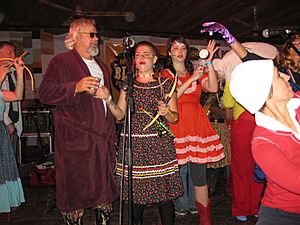Acadian Village (park) facts for kids
The Acadian Village is a special cultural park located in Lafayette, Louisiana. It's a place where you can step back in time and see what a traditional Cajun village looked like in the 1800s.
Contents
History of Acadian Village
In the early 1970s, people in Lafayette, Louisiana, wanted to boost tourism. They also wanted to create jobs for people with developmental disabilities. Dr. Norman Heard, Bob Lowe, and Glen Conrad came up with the idea for Acadian Village.
They wanted to use real old homes for the village. Many of these homes were abandoned. Families who owned them were contacted, and some homes were even given for free. The only cost was moving them!
To make it look like an 1800s Cajun village, they transformed 10 acres of farmland. U.S. Army Reservists helped dig bayous and build paths. Local carpenters and volunteers also joined in. The goal was to show how people lived long ago. As one director said, "the old ways are worth keeping alive."
Seven of the 11 buildings are real 19th-century homes. They were donated by families whose ancestors lived in them. These homes show how clever early Acadian builders were. They used wooden pegs, mud walls, and cypress wood. Each house was moved carefully, piece by piece, and then restored.
Today, Acadian Village hosts many events. These include Cajun festivals, weddings, and a special Christmas lighting program called Noël Acadien au Village. It's a great example of 19th-century Cajun life.
Art Gallery at Acadian Village
The Art Gallery was once the home of Dr. Hypolite Salles. He was the first dentist in Lafayette, Louisiana. The gallery is set up just like his dental office was in the late 1890s.
Now, the Art Gallery displays beautiful paintings. You can see landscapes, still life, and flower art from local artists. Often, these artists are working on new paintings right there in the gallery. All the artwork you see is original and available for sale.
Blacksmith Shop
The village has a replica of a blacksmith shop. It was built using old cypress wood. A blacksmith was very important in old communities. They made tools, horseshoes, nails, and hinges from iron.
Inside the shop, you can see an anvil, a forge, and bellows. These are tools used by blacksmiths long ago. There are also tongs, pincers, and hammers on the walls. You can also spot old farming tools that were essential for farmers in the past.
Historic Homes of Acadian Village
Thibodeaux House
The Thibodeaux House was built around 1820. It came from the Breaux Bridge, Louisiana area. It's made of cypress wood, which resists rot and insects. Each wooden beam was marked with Roman numerals to make it easy to put together. The small back room was for the daughter and could only be reached through the parents' room. Boys slept in the attic or loft, which had an outside staircase.
Bernard House
The Bernard House is the oldest building in the village. It was built in St. Martinville, Louisiana. The left side was built first, around 1800. The right side was added in 1840. Inside, you can see a large painting showing the Acadians being forced to leave Nova Scotia in 1755. Another painting shows their arrival in Louisiana in 1764–1765. These paintings were created by Louisiana artist Robert Dafford. The oldest part of the home has an exhibit about Cajun music. You can also see a great example of old insulation here. It's called bousillage entre poteaux, which means mud between posts.
Billeaud House
The Billeaud House comes from the Billeaud Sugar Plantation in Broussard, Louisiana. It was built before the American Civil War. Today, it's used as a spinning and weaving cottage. One of the looms is 150 years old. The other was built locally for the Bicentennial. People used to weave blankets and clothes from white cotton, which grew in Louisiana. They also used brown cotton, which was brought from Mexico to the Acadians by the Spaniards.
Castille House
The Castille House was built around 1860 in Breaux Bridge, Louisiana. It took the builder over a year to finish it by himself. During the Civil War, soldiers raided the house, but it survived. The cypress mantels inside are interesting. Each has a carved symbol. One looks like a Christian fish, meaning a long and happy life. The other looks like a rosette and is called progression, meaning a large and successful family.
LeBlanc House
The LeBlanc house was built between 1821 and 1856 near Youngsville, Louisiana. It is the birthplace of Acadian Senator Dudley J. LeBlanc. Dudley J. LeBlanc was a Cajun politician born on August 16, 1894. He served as a sergeant in the U.S. Army during World War I. He was elected to the Louisiana House of Representatives in 1924. He also served as a state senator for several terms.
St. John House
The St. John House dates back to about 1840. It was given to the village by a local dentist. It got its name because it was located on St. John Street in Lafayette. This house was built using salvaged cypress wood from another building. Today, the house is used as a schoolhouse. You can see old desks, inkwells, lunch pails, and a wooden stove, just like in an old school.
Noël Acadien au Village
Acadian Village becomes magical during the first three weeks of December for Noël Acadien au Village. This special event features local musicians, choirs, and bands. Every night, kids can take a photo with Santa and get it right away for a small fee.
A company called Christmas Depot lights up the entire village. It takes 10 to 12 people almost 2,000 hours to complete the job! They start planning in September and begin lighting the village in October and November. By mid-November, everything is ready for the holiday season.
See also


